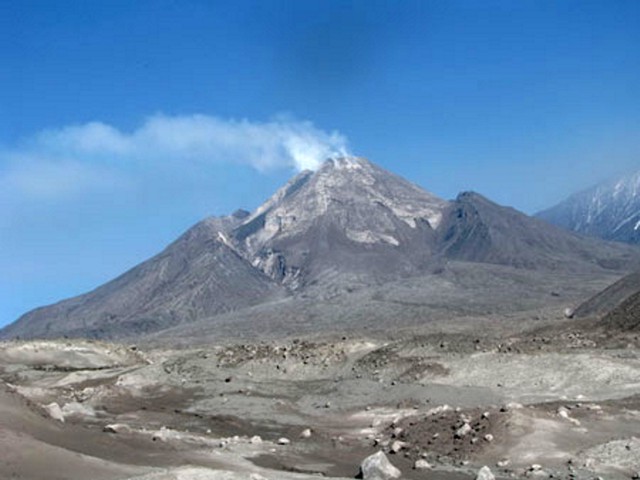Report on Bezymianny (Russia) — September 2008
Bulletin of the Global Volcanism Network, vol. 33, no. 9 (September 2008)
Managing Editor: Richard Wunderman.
Bezymianny (Russia) Seismicity, hot avalanches, and dome growth during July 2008
Please cite this report as:
Global Volcanism Program, 2008. Report on Bezymianny (Russia) (Wunderman, R., ed.). Bulletin of the Global Volcanism Network, 33:9. Smithsonian Institution. https://doi.org/10.5479/si.GVP.BGVN200809-300250
Bezymianny
Russia
55.972°N, 160.595°E; summit elev. 2882 m
All times are local (unless otherwise noted)
Between May and December 2007 there was increased seismic activity with ash plumes and lava emission (BGVN 32:11) at Bezymianny (figure 7). No further reports were available about this volcano until July 2008.
On 12 July 2008, the Kamchatkan Volcanic Eruption Response Team (KVERT) reported increased seismicity, with shallow earthquakes, and raised the Level of Concern Color Code to Orange. According to KVERT, intermittent volcanic tremor at Bezymianny was detected on 11 July, along with hot avalanches and strong fumarolic activity. On 11 and 15 July, satellite imagery detected weak thermal anomalies over the lava dome. On 15 July, local observers reported hot avalanches.
Seismic activity remained above background levels through 17 July (table 4), but then declined to background levels (except for a one-day increase on 20 July). Weak to moderate fumarolic activity was observed during 18-22 July. Volcanologists saw the growing dome extruding a viscous lava flow. Weak thermal anomalies over the lava dome were detected in satellite imagery on 18, 19, and 20 July. KVERT lowered the level of Concern Color Code to Yellow.
Table 4. Seismicity at Bezymianny and visual observations for the interval from 6 June to July 2008. Ks refers to a magnitude classification determined from S-wave amplitude (as defined by Sergei Fedotov). Courtesy of KVERT and Kamchatka Branch of the Geophysical Service of the Russian Academy of Sciences (KB GS RAS).
| Date | Earthquakes, Ks | Comments |
| 06 Jun 2008 | 4.0 | Obscured by clouds |
| 10 Jun 2008 | 4.3 | Obscured by clouds |
| 13 Jun 2008 | 4.2 | Obscured by clouds |
| 17 Jun 2008 | 4.3 | Obscured by clouds |
| 08 Jul 2008 | 4.0 | Obscured by clouds |
| 09 Jul 2008 | 4.7 | Obscured by clouds |
| 11 Jul 2008 | tremor | Hot avalanches, strong fumarolic activity, thermal anomaly |
| 12 Jul 2008 | Over 4.0 and one over 5.0 | Obscured by clouds |
| 13 Jul 2008 | 4.0-5.0 | Obscured by clouds |
| 14 Jul 2008 | 4.0-5.0 | Obscured by clouds |
| 15 Jul 2008 | 4.0-5.0 | Hot avalanches, thermal anomaly |
| 16 Jul 2008 | 4.0-5.0 | Obscured by clouds |
| 17 Jul 2008 | 4.0 | Explosive activity of the volcano and new pyroclastic flows, thermal anomaly |
| 20 Jul 2008 | 4.0 | An effusion of viscous lava flow at the lava dome and moderate fumarolic activity, thermal anomaly |
| 27 Jul 2008 | 4.5 | Fumarolic activity, thermal anomaly |
Reference. Fedotov, S.A., Chernisheva, G.V., and Shumilina, L.S., 1993, The estimation of the seismic danger of the earthquakes of M 6, which accompany the strong (M 8) Pacific Ocean earthquakes: Volcanology and Seismology, no. 6, p. 3-12 (in Russian).
Geological Summary. The modern Bezymianny, much smaller than its massive neighbors Kamen and Kliuchevskoi on the Kamchatka Peninsula, was formed about 4,700 years ago over a late-Pleistocene lava-dome complex and an edifice built about 11,000-7,000 years ago. Three periods of intensified activity have occurred during the past 3,000 years. The latest period, which was preceded by a 1,000-year quiescence, began with the dramatic 1955-56 eruption. This eruption, similar to that of St. Helens in 1980, produced a large open crater that was formed by collapse of the summit and an associated lateral blast. Subsequent episodic but ongoing lava-dome growth, accompanied by intermittent explosive activity and pyroclastic flows, has largely filled the 1956 crater.
Information Contacts: Kamchatka Volcanic Eruptions Response Team (KVERT), Institute of Volcanology and Seismology (IVS), Far East Division, Russian Academy of Sciences, Piip Ave. 9, Petropavlovsk-Kamchatsky, 683006, Russia (URL: http://www.kscnet.ru/ivs/); Olga Girina, KVERT, IV&S.


